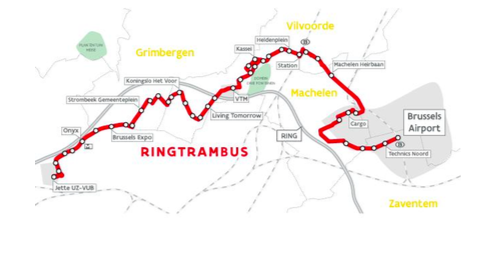First trambus in Belgium makes maiden trip
Flemish Minister for Mobility Ben Weyts and De Lijn have presented the country’s first ‘trambus’. The ‘trambus’ derives its name from the unique combination of the comfort of a tram and the manoeuvrability of a bus. The Flemish transport company De Lijn is expanding its green fleet with fourteen of this hybrid vehicle. The first trip of the trambus passed Machelen and Zaventem, on a section of the future route of the ‘Ringtrambus’ that will run from September between Brussels Expo and Brussels Airport. This is a double first: the first trambus on the longest combined bus lane (16 km). “The trambus offers comfort and speed: a persuasive proposal to tempt more travellers in the Brussels Periphery to take public transport,” says Weyts.
Quiet, accessible, environmentally friendly
With the comfort and the capacity of a tram and the flexibility of a bus, the trambus is a striking newcomer on the road. With its length of 24 metres, the trambus approaches the feeling of space of a tram: it offers places for 137 passengers, and also for prams, luggage or bicycles. The 4 wide doors and the low floor ensure, in combination with accessible stops, for a smooth entry and exit of the passengers. Due to its length, the double articulated trambus guarantees modern comfort and a pleasant travel experience. The smaller rear section and the slightly rotating rear fourth axle ensure that the vehicle can smoothly take corners.
The advanced enclosed cab provides a safe driving experience for the driver who can concentrate fully on the road. Thanks to camera images instead of mirrors, the driver also has a good view from his position of boarding and alighting passengers.
Ben Weyts, Flemish Minister of Mobility: “The trambus will tempt commuters to more often leave their car at home and use public transport instead. This is high-quality public transport that offers speed and comfort to large groups of passengers. We offer this brand-new choice at the place where the demand is highest: in the Flemish Periphery of Brussels, between large poles of economic activity and employment.” `
Roger Kesteloot, CEO of De Lijn: “We are proud that our drivers and passengers can drive around in the first trambuses in Flanders. The trambus is a very fine addition to our existing fleet, which we are greening as much as possible. The hybrid trambuses are good for the environment: they are good news for those who live and travel in the North Periphery of Brussels, because the trambuses are up to 25% less noisy and more economical. What’s more, thanks to these fourteen hybrid trambuses, we will be saving around 200,000 litres of diesel every year.”
A first in Belgium.
The trambus is being used on Belgian soil for the very first time. The designer, bus constructor Van Hool, previously produced similar vehicles for some countries including Sweden and Switzerland. From September, De Lijn will be deploying fourteen trambuses in the Flemish Periphery of Brussels. First De Lijn will be thoroughly testing the trambuses and training its instructors and drivers.

The Ringtrambus is the first implementation of the Brabantnet: 3 high-quality public transport routes that will make the Flemish Periphery more easily accessible. The route connects important locations in the northern Brussels Periphery, including the University Hospital in Jette, the Heizel, Strombeek-Bever, the centre and station of Vilvoorde and Brussels Airport. During the major works on the Brussels Ring Road, the Ringtrambus will provide a strong alternative that can contribute significantly to reducing the inconvenience.
Congestion-free passage from Brussels Expo to Brussels Airport
In the Brussels Periphery there is a great need for alternatives to the car, for it is one of the most congestion-sensitive regions in Flanders. Thanks to the Ringtrambus, the mobility in the whole northern region can be improved.
With 16 kilometres the longest combined bus lane in Flanders
In the coming three years, the Ringtrambus will have 16 kilometres of free bus lanes, which will be taken into use sectkon by section. This will systematically improve the flow of traffic on the route. The bus lanes do, after all, guarantee a congestion-free passage and more punctual arrival and departure times.
The Werkvennootschap has already carried out a number of modifications to stops and streets in Vilvoorde, Grimbergen, Machelen and Brussels Airport. Last summer, for example, free bus lanes were created in both directions on Luchthavenlaan in Vilvoorde, between the De Vuist intersection and the Mima Bridge. A new comfortable tram terminal stop is also under construction at Brussels Airport.
A facelift for the neighbourhood
De Werkvennootschap is coordinating the reconstruction of 25 streets and squares in preparation for the Ringtrambus. At the same time, the neighbourhood will be given an attractive facelift. No less than 23 km of new and improved cycle paths will be created built along the Ringtrambus route, 930 places will be created in new bicycle sheds and 600 trees will be planted. Certain traffic junctions – such as the current roundabouts at Heldenplein in Vilvoorde – will receive a structural solution as a result of these works.
Temporary use on bus line 820
De Lijn will not be waiting until De Werkvennootschap has completed its work in order to take the trambuses into service. From September, the vehicles will be used on bus route 820 between Brussels Airport and the Brussels University Hospital in Jette. They will travel via Brucargo, the station and the centre of Vilvoorde, the Kassei neighbourhood, the employment area around the Medialaan, Strombeek and the Heysel.
The Ringtrambus in brief
- Length of vehicle: 24 m (an articulated bus is 18m long, a standard bus 12 m)
- Vehicle capacity: 137 passengers: 51 seats and 86 standing
- Longest combined bus lane in Flanders: 16 km of free bus lanes over the entire length of the route
- Important areas along the route: UZ VUB Jette, Brussels-Expo, Strombeek-Bever
- Koningslo, Medialaan, the centre and station of Vilvoorde, Brucargo and Brussels Airport



